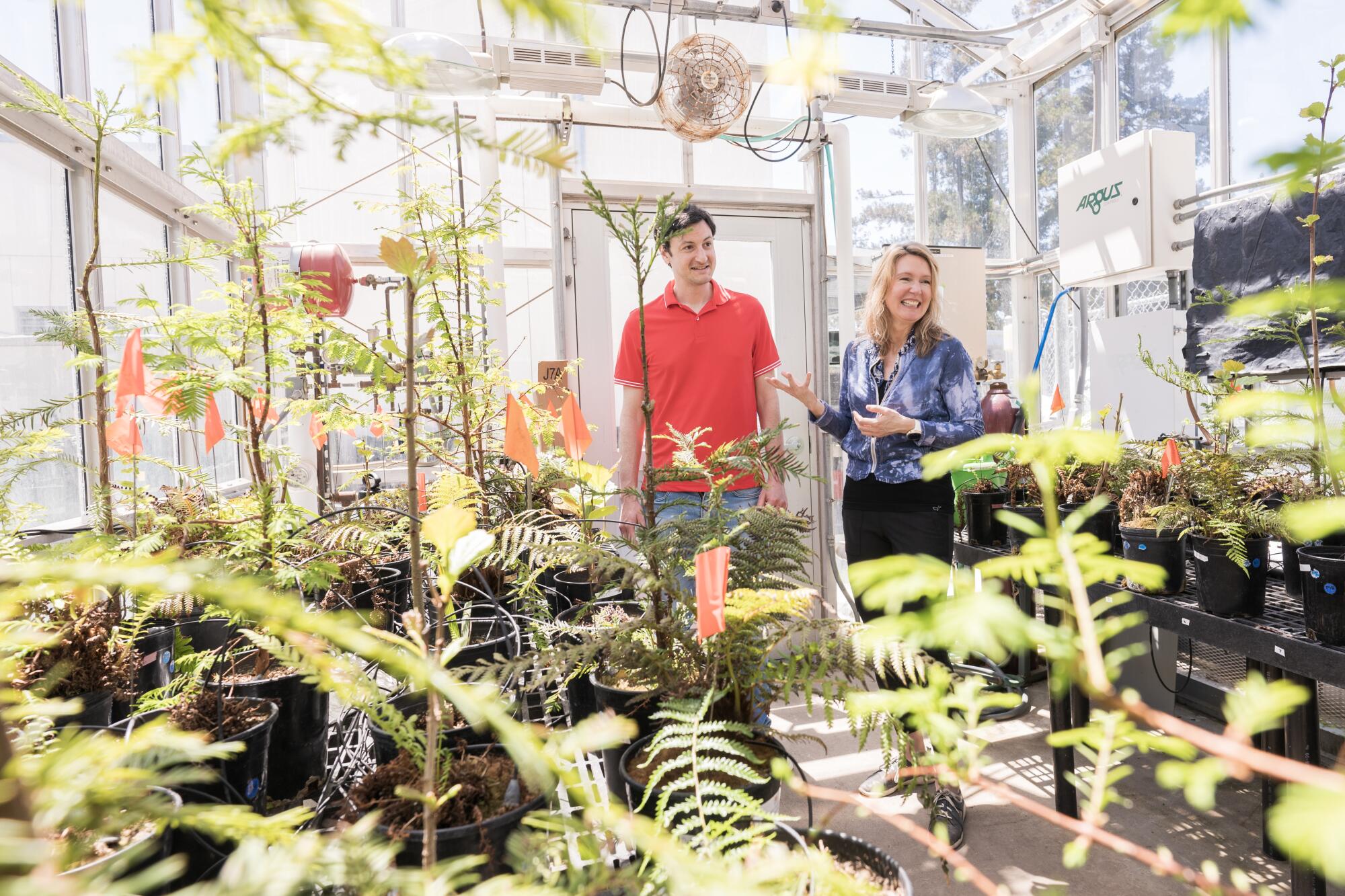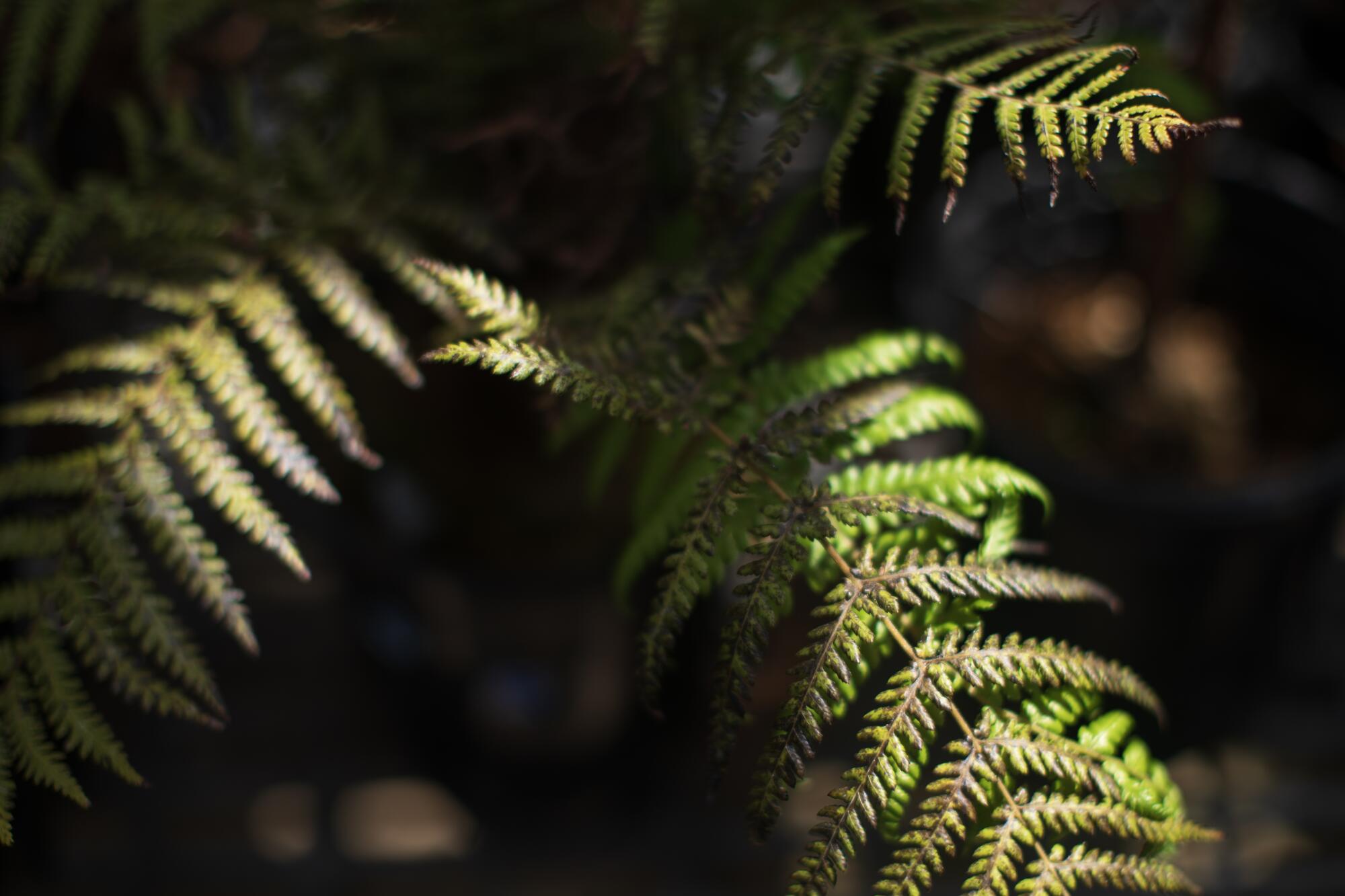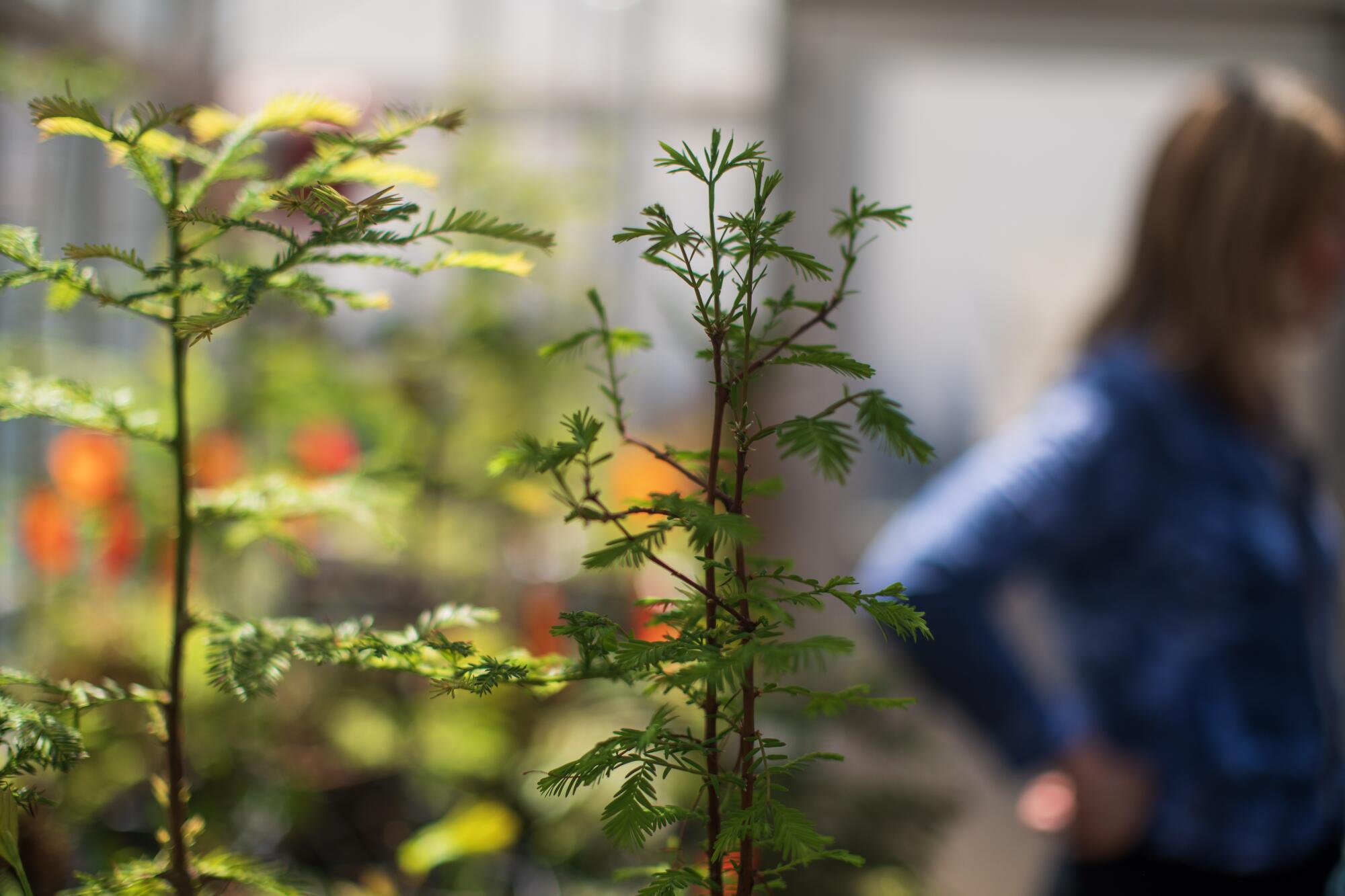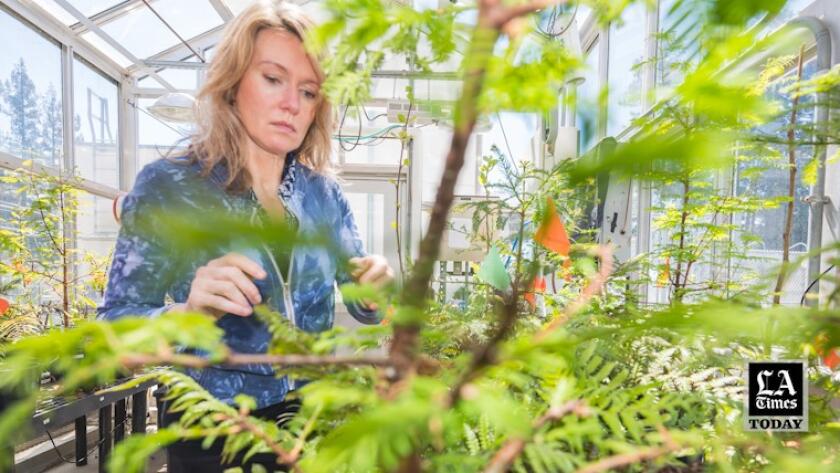
- Share via
SANTA CRUZ — As bad days go, it’s hard to top the one 66 million years ago when a space rock the size of Paris slammed into Earth at 45,000 mph.
The heat of impact generated massive fires that annihilated everything around them and sent colossal plumes of pollutants soaring into the atmosphere. Within a day or two, toxic clouds of pulverized rock, sulfate aerosols and wildfire soot had blanketed the planet, blocking all but a tiny fraction of the sun’s energy and bringing photosynthesis to a virtual halt for the only known time in history.
No event before or since has so thoroughly devastated the basic processes that make life possible here. Earth became a dark, noxious landscape of dead vegetation littered with charred carcasses of dinosaurs, pterosaurs and other creatures.
By the time the Cretaceous-Paleogene, or K-Pg, extinction event was over, about three-quarters of species alive at the time of impact had disappeared forever.

Eventually, the first green shoots of life emerged from the detritus. No one knows exactly when these first buds appeared, but the fossil record tells us what they were: ferns. Lots of them.
The dinosaurs’ demise gets all the attention, but the survival of plants is at least as important a chapter in the story of the planet. Why did ferns thrive when almost everything else was destroyed? And what could their extraordinary hardiness tell us about how today’s ecosystems might fare after another cataclysm?
Fortunately, “it’s actually not that hard to simulate a mass extinction,” said Emily Sessa, a plant systematist at the New York Botanical Garden in the Bronx.
That’s exactly what her team is doing.
Sessa is the principal investigator on a NASA-funded project to explore the recovery of ferns in the post-extinction world. By comparing fossil evidence to observations of plants in apocalypse-like conditions, the team hopes to better understand how this humble flora amassed one of the most impressive track records of survival on Earth and how its strength catalyzed recovery of the rest of the planet.
Fossil records from North America indicate dinosaurs were still in their prime 66 million years ago, but the asteroid that struck Earth wiped them out anyway.
The work caught the attention of NASA, which has a long-standing interest in understanding the factors that compel evolution and extinction on this planet — and, potentially, on others.
“To understand the response that ferns had to this enormous cataclysm can be very informative,” said Dr. Lindsay Hays, lead program officer for NASA’s Exobiology Research Program. She said she hopes the experiment will offer new insights into how epoch-ending events “can be important drivers for life elsewhere.”
The ambitious study began as a sketch on the back of a cocktail napkin at a hotel bar where Sessa, then a professor of plant systematics at the University of Florida, and Jarmila Pittermann, a professor of plant physiology at UC Santa Cruz, were debriefing after a conference. Both shared an academic interest in ferns and knew that NASA was funding research on exobiology, the study of potential life beyond Earth.
Given that the fossil record shows a spike in the distribution of fern spores at a time when hardly anything else had managed to stay alive, the pair wondered what the plants might tell us about what it takes to survive in hostile and unlikely environments. The ferns, it turned out, would indeed have much to tell.
Pittermann and Sessa reached out to Regan Dunn, a paleobotanist at the La Brea Tar Pits, and Ellen Currano, a paleobotanist at the University of Wyoming, and asked them to collect samples of early Paleogene rock that might have fossil evidence of the fern spore spike. Dunn and Currano spent a month in the field looking for rocks bearing the telltale stripe of iridium deposits the asteroid strike left on Earth. They bored samples above and below the line in five locations in New Mexico and Colorado and combed the sites for leaf fossils to find out what kind of ferns existed at the time of impact.
They sent the samples to a specialized commercial laboratory that crushed the rock and dissolved the minerals, leaving behind fern and fungi spores, pollen grains, leaf fragments and other microscopic traces of prehistoric plant life. Paleoecologist Jacqueline Gill of the University of Maine helped them analyze it all.
Then it was a matter of comparing the historical evidence against data collected during a real-life reenactment of the K-Pg catastrophe.

That meant creating a post-apocalyptic scenario in a greenhouse on the roof of UC Santa Cruz’s Interdisciplinary Sciences Building.
The 12-by-20-square-foot space was outfitted last summer with roughly 140 plants representative of the late Cretaceous: spiky palms, feathery metasequoia, frilly ferns. Among the ferns was a variety called Blechnum spicant, also known as a hard fern or deer fern. Versions of this plant were on the planet for nearly 300 million years before the space rock barreled into Earth.
For more than three months, the plants flourished in their one-gallon pots in atmospheric conditions similar to those at the time of the asteroid impact: warm and humid with carbon dioxide levels of 1,000 parts per million, more than twice that of our current atmosphere.
“Happy Cretaceous conditions,” Pittermann said.
Those conditions changed abruptly in late October.
Research specialist Alex Baer painted the greenhouse’s exterior with several coats of whitewash mixed with a hardener to block the sun’s rays and help the coating withstand winter rainstorms. Then he strung tarps and sheets of Mylar over the ceiling to block out any remaining light.

To complete the transformation, Baer slashed the temperature from a balmy 77 degrees Fahrenheit to 50 degrees and gave the plants regular spritzes of a solution designed to mimic the acid rain believed to have fallen on the post-impact world.
Within a month, what had been a lush collection of foliage looked like a sad gathering of abandoned houseplants.
The deciduous plants entered winter mode and dropped their leaves in the first week, Pittermann said — a surprisingly quick collapse that underscored the swiftness of the K-Pg extinction.
The La Brea Tar Pits were recognized as one of the world’s First 100 IUGS Geological Heritage Sites for their stunning Ice Age fossil record.
Others died more drawn-out deaths.
“With the Blechnum, what we saw was more of a cringy, slow loss of the leaves,” Baer said. “It appeared like it was sort of suffering.”
For the record:
2:18 p.m. May 31, 2023An earlier version of this story misidentified the plant that was neither growing nor deteriorating. It was Sequoia sempervirens, or coast redwood, not metasequoia, or dawn redwood.
Some plants showed traces of their ancestors’ resilience in the face of calamity. The Sequoia sempervirens, or coast redwood, entered a sort of plant limbo in the darkness, neither growing nor showing visible signs of decline.
But what about the Blechnum? As the dark phase wore on, its survival seemed uncertain.
Scientists believe it took anywhere from two years to several decades for daylight and temperature to return to pre-impact levels. Practicality demanded that the research team shorten that timeline. So in mid-April, after about six months of artificial impact winter, the tarps came down, the acid baths stopped and the whitewash was scraped off the glass, an abbreviated version of the Paleogene’s gradual readjustment.
The researchers knew life could return after such awful conditions — we wouldn’t be around if it couldn’t. But how long it would take and what recovery would look like remained to be seen.
The first spring-green buds began to emerge alongside the withered brown remains within days of the light’s return. Two weeks later, fern fronds spilled from several pots, and the tiny sequoia and sycamore saplings once again had leaves.
Only the Blechnum seemed not to have weathered the agonizing collapse: When Baer cut a sample for analysis, he could find no trace of healthy rhizome, or fern stem, as the other plants had. On a recent walk through the greenhouse, Baer inspected a pot that contained its dry, apparently lifeless remnants.
Suddenly, Pittermann gasped. There, poking up through the soil, was a tiny green tendril. The Blechnum had made it after all, just as its ancestor did 66 million years ago.

Asked whether ferns could be considered the cockroach of the plant world, Pittermann demurred, offering only that they are “resilient.” But they are an exceptionally hardy class of plants.
“They actually have a special type of photoreceptor that flowering plants and other seed plants do not have, so they’re able to photosynthesize in really low light conditions,” Sessa said. Ferns are also tolerant of acidic and nutrient-poor soils, and some species can absorb heavy metals from contaminated soil, in effect cleaning the earth with their presence.
In the wake of a disaster, be it a forest fire or a giant meteor strike, “if they’re able to get in there and start absorbing heavy metals out of the soil and doing their normal sort of processes of living and dying, they’re then going to create new organic matter,” Sessa said. “They basically just act as the first pioneer or colonizer species that are able to get a hold on a devastated kind of landscape and start to bring some life back to it.”
The fossil record suggested this, but the Santa Cruz experiment was the first to show how that actually happened.
While comparing fossilized specimens to analogous living creatures is “an old tradition in paleontology,” no research team has used the method to explore the K-Pg extinction, said Scott Wing, a geologist and curator of paleobotany at the Smithsonian Institution.
“If you want to understand the effects of global devastation on ecosystems and evolution, this is the first chapter in Earth history to turn to,” Wing said. “It is also a great chapter for trying to understand how life recovers over both ecological and evolutionary time.”
Accelerating wildfires played a key role in the Great Dying by destroying ecosystems too quickly for plant and animal species to adapt.
Figuring out how ecosystems rebound from catastrophe isn’t just about understanding the planet’s past. The discoveries could help secure its future.
Earth’s inhabitants are not the sitting ducks they were in the late Cretaceous. NASA can see potentially dangerous asteroids coming decades in advance and is developing ways to protect us from those headed our way. Last year, NASA successfully knocked a moving space object off course for the first time, a key step in planetary defense.
But it’s worth knowing what might happen in a worst-case scenario that suddenly triggered such conditions, be it an interloper from outer space or a homegrown nuclear attack. Even if our species was toast, there’s encouraging evidence that life on the planet — especially the fern kind — would find a way to carry on without us.
- Share via
Watch L.A. Times Today at 7 p.m. on Spectrum News 1 on Channel 1 or live stream on the Spectrum News App. Palos Verdes Peninsula and Orange County viewers can watch on Cox Systems on channel 99.













